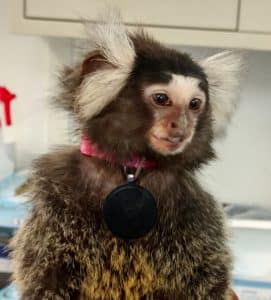Podcast: Play in new window | Download (Duration: 10:03 — 23.4MB)
Subscribe: Apple Podcasts | TuneIn | RSS | More

What does a monkey wearing a Fitbit-like device have to do with Parkinson’s disease? A newly-published study shows marmosets at the Southwest National Primate Research Center can mimic the non-motor symptoms of Parkinson’s.
Marmosets are small, New World monkeys that can mimic the sleep disturbances, changes in circadian rhythm, and cognitive impairment people with Parkinson’s disease develop.
Associate Scientist Marcel Daadi, Ph.D., leader of the Regenerative Medicine and Aging Unit at the SNPRC, is the lead author of a new study published in the journal PLOS ONE. In addition to monitoring the marmosets, scientists videotaped the animals to document their ability to perform certain tasks and how those abilities were impacted over time by the disease.
By developing an effective animal model that can emulate both the motor and non-motor symptoms of Parkinson’s disease, scientists have a better chance of understanding the molecular mechanisms of the neuro-circuitry responsible for changes in the brain during the course of the disease. Scans like magnetic resonance imaging (MRIs) and analysis after dissections may lead to potential targets for new therapies for patients.